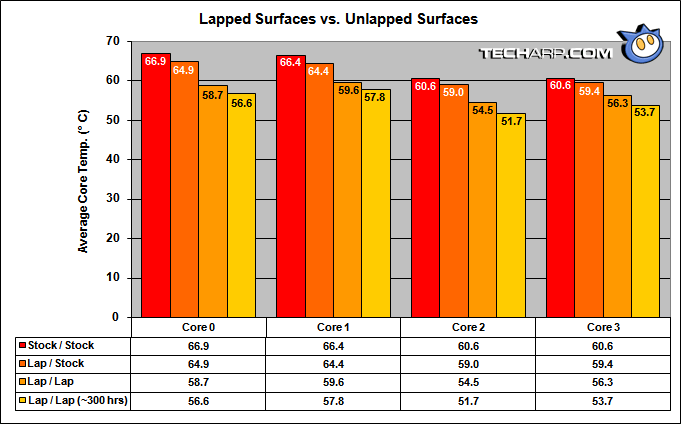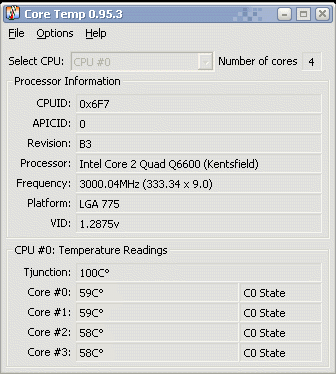Overall Results
Okay, let's take a look at the overall results. Again, the same testbed was used.
Processor |
Intel Core 2 Quad Q6600 |
|
Motherboard |
ASUS P5B Deluxe |
|
Heatsink |
Thermalright Ultra-120 eXtreme |
|
Fan |
Scythe S-FLEX SFF21F (1600 RPM) |
|
Chassis |
Antec P182 |
|
The temperature data was measured using SpeedFan while encoding a x264 video from a 720x480 DVD source using a high quality video profile, over a period of ~1 hour. All 4 CPU cores were used, with a CPU load of >99 %.
I had the SpeedFan log the temperatures every 3-4 seconds averaged the whole data set per core, for the second pass of the 2-pass encode. This is because the second pass is the most CPU intensive.
Room temperature before and after the lapping tests were between 20-22 °C. I also added a constant of 15 to each core in SpeedFan since it incorrectly displays temperatures for quad-core processors by 15 °C.

After lapping both heatsink base and CPU IHS, the CPU core temperatures immediately dropped by 4.3-8.2 °C (7-12 %). That's a really significant improvement in thermal dissipation. After about 300 hours of use later, the results improved further with the cores recording temperatures 6.9-10.3 °C (11-15 %) lower than the baseline.
Temperature Variation Between CPU Cores
 I should also mention that before I lapped the CPU, I noted a pretty big difference in core temperatures in Core Temp (see picture on right) when I tried Prime 95 v25.x or two instances of Orthos (2x Orthos).
I should also mention that before I lapped the CPU, I noted a pretty big difference in core temperatures in Core Temp (see picture on right) when I tried Prime 95 v25.x or two instances of Orthos (2x Orthos).
There was a temperature difference of up to 6 °C between one core to another. Lapping the CPU's heatspreader really evened out the temperature of all four cores.
As you can see from the Core Temp results on the right, the maximum temperature difference of all four cores was now only 1 °C when stressed with Prime 95 v25.3.
This large reduction in temperature difference between the four cores was seen after I lapped both the heatsink base and the CPU heatspreader.
Do note that the core temperature results here cannot be compared with that of the table above, because the results above was based on video encoding, not Prime 95. The x264 encoder is good at using all four cores, but not as efficient as Prime 95 or Orthos in stressing all four cores. This accounts for the large difference in core temperatures seen in the table above.
<<< Lapping The CPU Heatspreader, After Lapping The CPU Heatspreader : Previous Page | Next Page : So How Do You Lap? >>>







 Add to Reddit
Add to Reddit
